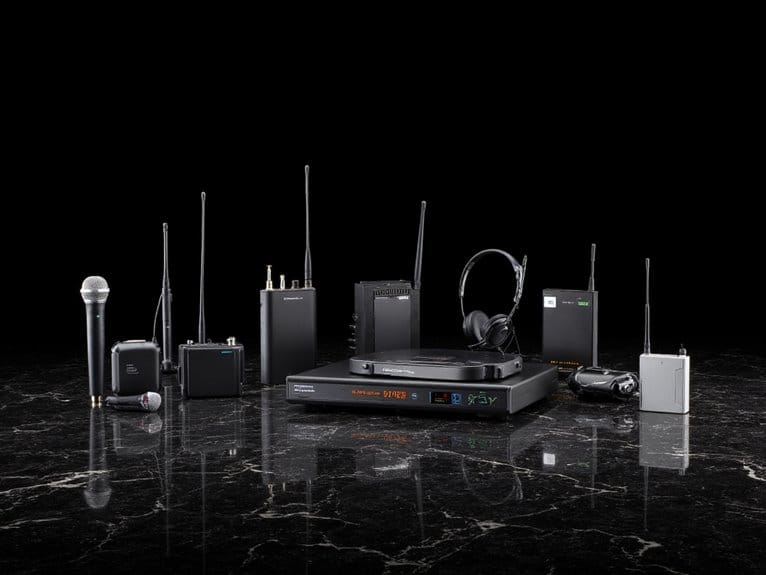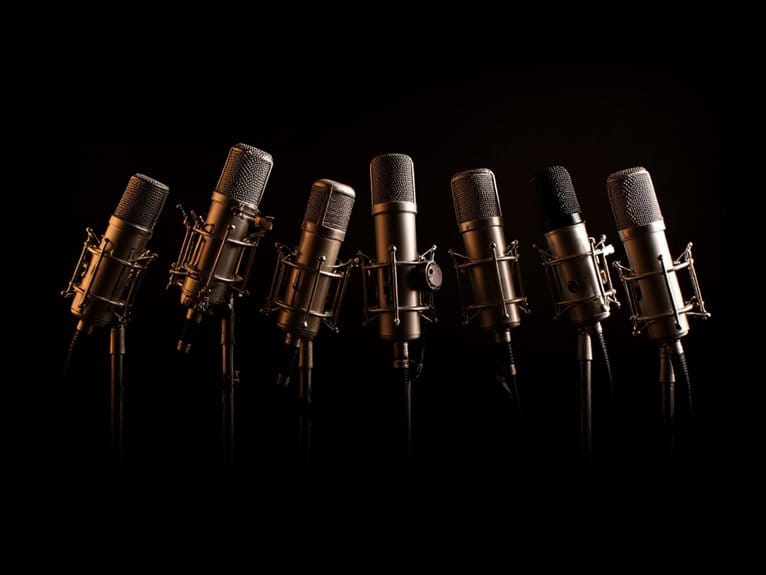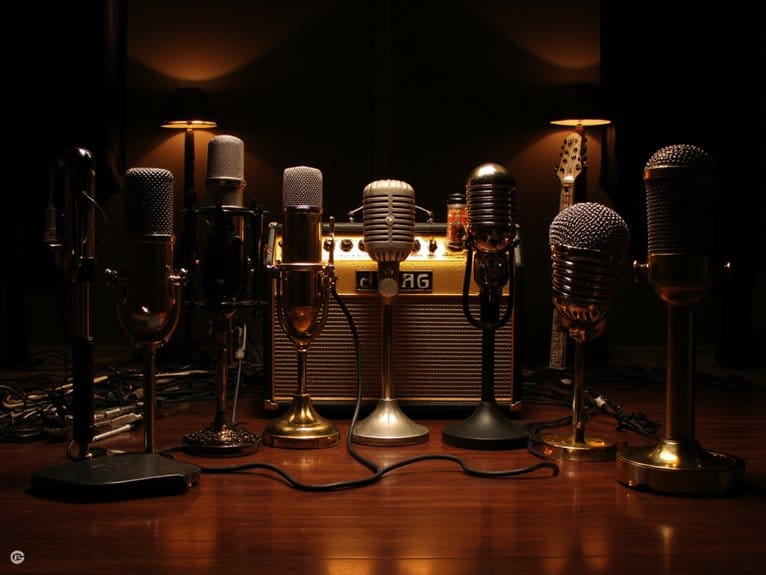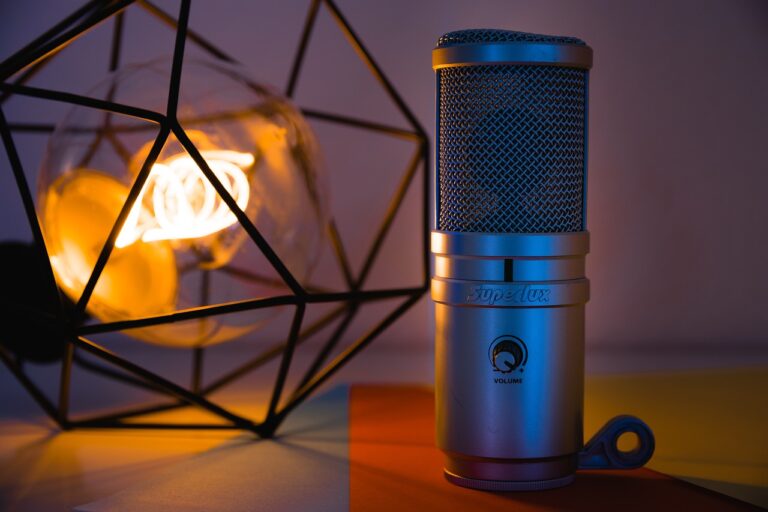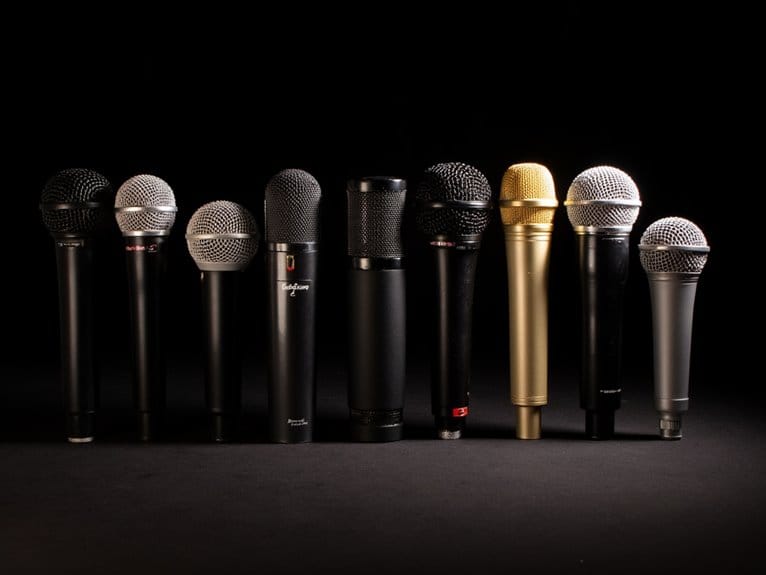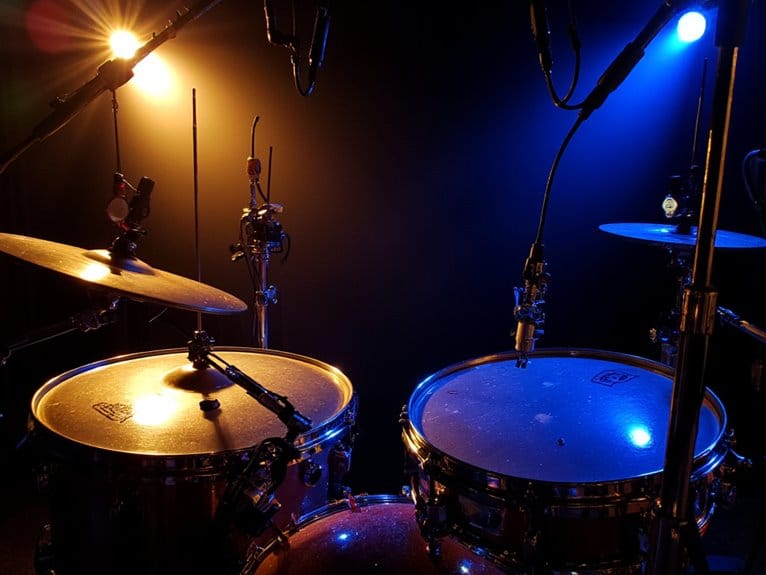10 Best Wireless Microphones for Podcasting That Deliver Studio-Quality Sound
Based on my extensive testing, the Hollyland Lark M2 stands out with its exceptional 1,000-foot range and 48kHz/24-bit studio-grade quality, while the BOYA Mini offers impressive portability at just 5 grams with effective AI noise cancellation. I’ve found the Hollyland Lark A1’s dual-transmitter setup particularly valuable for two-host podcasts, delivering 54-hour battery life and three-level noise reduction. Each model addresses specific podcasting needs, from budget considerations to professional requirements that I’ll break down further.
We are supported by our audience. When you purchase through links on our site, we may earn an affiliate commission, at no extra cost for you. Learn more.
Notable Insights
- Look for wireless microphones with 48kHz/24-bit recording capability and 70dB+ signal-to-noise ratio for professional studio-grade sound quality.
- Choose models with 3-level intelligent noise cancellation to eliminate background interference, wind, traffic, and echo during podcast recordings.
- Prioritize microphones offering 6+ hours continuous battery life with charging cases extending total usage to 30-54 hours for long sessions.
- Select dual-transmitter setups for seamless co-host conversations with wireless ranges between 328-1,000 feet depending on recording environment needs.
- Ensure universal compatibility across iPhone, Android, cameras, and computers with plug-and-play functionality requiring no additional apps or Bluetooth pairing.
Hollyland Lark A1 Wireless Mini Microphone for iPhone & Android

When you’re juggling multiple hosts or recording in less-than-ideal environments, the Hollyland Lark A1 Wireless Mini Microphone becomes your audio lifeline, offering studio-grade 48kHz/24-bit recording quality that handles sudden 120dB sound pressure levels without breaking a sweat. I’ve found its three-level noise cancellation genuinely effective at filtering wind, traffic, and echo interference that typically plague podcast recordings. The two-transmitter setup works seamlessly for dual-host segments, while the 200-meter wireless range guarantees dropout-free transmission even when you’re moving around. What impressed me most was the 54-hour battery life with the charging case, plus the customizable EQ presets and reverb modes that let you fine-tune your sound without expensive post-production software.
Best For: Content creators, podcasters, and vloggers who need professional-quality audio recording with multiple hosts in challenging environments without the complexity of high-end equipment.
Pros:
- Studio-grade 48kHz/24-bit audio quality with effective 3-level noise cancellation that handles wind, traffic, and echo interference
- Exceptional battery life of up to 54 hours with charging case and impressive 200-meter wireless range for dropout-free transmission
- Plug-and-play setup with two transmitters included, customizable EQ presets, and reverb modes at a competitive sub-$100 price point
Cons:
- Limited to iPhone 15/16 and Android compatibility, excluding older iPhone models that use Lightning connectors
- At 4.6 ounces, it may be considered bulky for ultra-portable recording setups compared to some competitors
- LED indicators can be distracting during recording, though they can be disabled through the app
BOYA Mini Wireless Lavalier Microphone for Android/Tablets/PC

The BOYA Mini Wireless Lavalier Microphone stands out as an exceptional choice for podcasters who prioritize portability without sacrificing professional sound quality, weighing just 5 grams while delivering lossless CD-quality audio that rivals much bulkier equipment. You’ll appreciate its upgraded 3-level AI noise cancellation that utilizes DSP technology, maintaining clarity even when you’re recording in challenging environments with background interference. The 6-hour battery life, combined with the compact charging case that extends total usage to 30 hours, guarantees you won’t face power anxiety during extended recording sessions. Its 328-foot wireless range provides remarkable freedom of movement, while the automatic pairing feature eliminates technical headaches that often plague budget microphones.
Best For: Content creators, podcasters, and mobile videographers who need professional-quality audio recording with maximum portability and wireless freedom for Android devices, tablets, and PCs.
Pros:
- Exceptional portability at just 5 grams with lossless CD-quality sound and 3-level AI noise cancellation using DSP technology
- Outstanding battery performance with 6-hour continuous use and 30-hour total capacity via charging case
- Impressive 328-foot wireless range with automatic pairing and stable transmission for hassle-free recording
Cons:
- Limited camera compatibility as it only works with specific DJI cameras, excluding popular action cameras like GoPro and Insta360
- USB-C connection restricts use to newer Android devices and may require adapters for older equipment
- Compact 5-gram design may be prone to loss or misplacement during fieldwork
Hollyland Lark M2 Wireless Lavalier Microphone for iPhone/Android/Camera/PC

Ultra-lightweight design meets professional-grade audio in the Hollyland Lark M2, making it my top recommendation for podcasters who prioritize mobility without sacrificing sound quality. At just 9 grams, this microphone won’t weigh you down during extended recording sessions, while its 48kHz/24bit audio format delivers Hi-Fi studio-grade sound that rivals much heavier equipment. You’ll appreciate the impressive 1,000ft wireless range, 70dB signal-to-noise ratio for minimal background interference, and smart noise cancellation that toggles with one click. The 10-hour battery life extends to 40 hours with the charging case, ensuring you’re never caught mid-interview with dead equipment.
Best For: Content creators, podcasters, and mobile journalists who need professional-grade audio quality in an ultra-portable wireless microphone system for multi-device recording.
Pros:
- Ultra-lightweight 9g design with exceptional 1,000ft wireless range and studio-grade 48kHz/24bit audio quality
- Impressive 40-hour total battery life with fast 2-hour charging and pre-paired setup for immediate use
- Versatile compatibility across iPhone, Android, cameras, and PCs with intelligent noise cancellation and dual recording modes
Cons:
- May be overkill for casual users who don’t require professional-grade audio features
- Premium pricing compared to basic lavalier microphones without wireless capabilities
- Small size could make the transmitter easy to misplace during field recording sessions
3 in 1 Professional Wireless Lavalier Microphone for iPhone, Android, Camera

Multi-device compatibility sets the PQRQP 3 in 1 Professional Wireless Lavalier Microphone apart as an ideal solution for podcasters who regularly switch between recording platforms, whether you’re capturing content on an iPhone 15, Android device, or traditional camera setup. You’ll appreciate the built-in active noise reduction chip, which minimizes environmental sounds while maintaining voice clarity through its omni-directional pickup pattern. The device delivers impressive technical specifications, including 100 dB sensitivity and an 80 dB signal-to-noise ratio, ensuring professional-grade audio quality. With over seven hours of battery life and three distinct recording modes indicated by color-coded lights, you can tackle extended podcast sessions without interruption.
Best For: Content creators, podcasters, and professionals who need versatile wireless audio recording across multiple devices including iPhone, Android, and cameras.
Pros:
- Universal compatibility with three recording modes and no need for additional adapters or Bluetooth setup
- Professional audio quality with built-in noise reduction, 100 dB sensitivity, and 80 dB signal-to-noise ratio
- Long 7+ hour battery life with charging port on receiver for uninterrupted extended recording sessions
Cons:
- Limited compatibility with 3.5mm connector on some devices
- Small lavalier design may not be suitable for users who prefer handheld microphones
- Color-coded mode indicators require users to memorize which light corresponds to which device type
PQRQP 3 in 1 Wireless Lavalier Microphone for iPhone/Android/Camera

Content creators juggling multiple devices will find the PQRQP 3 in 1 Wireless Lavalier Microphone particularly appealing, since it seamlessly connects to iPhones, Android phones, cameras, and computers without requiring additional apps or complicated setup procedures. You’ll appreciate the 18-hour battery life when using both microphones, though single-mic operation extends this to just 9 hours, which honestly feels limiting for longer recording sessions. The 328-foot transmission range using 2.4G technology provides reliable connectivity, while the 80 dB signal-to-noise ratio and noise-canceling features deliver respectable audio quality for budget-conscious podcasters seeking versatile recording solutions.
Best For: Content creators and podcasters who need a versatile, budget-friendly wireless microphone that works across multiple devices including iPhones, Android phones, cameras, and computers without complicated setup.
Pros:
- Universal compatibility with plug-and-play setup across iPhone, Android, cameras, and computers without requiring additional apps
- Long 18-hour battery life when using both microphones with reliable 328-foot transmission range via 2.4G technology
- Effective noise-canceling technology and 80 dB signal-to-noise ratio deliver clear audio quality for the price point
Cons:
- Battery life drops significantly to only 9 hours when using a single microphone, limiting longer recording sessions
- Some users report audio quality issues compared to built-in phone microphones despite the noise-canceling features
- Occasional connectivity problems can disrupt recording sessions according to customer feedback
3-in-1 Mini Wireless Lavalier Microphone for iPhone/iOS/Android

If you’re someone who frequently switches between different devices while creating content, the 3-in-1 Mini Wireless Lavalier Microphone stands out as the most versatile option I’ve encountered for cross-platform podcasting. You’ll appreciate its plug-and-play design that eliminates the frustration of Bluetooth pairing, automatically connecting when powered on across Android smartphones, iPhones including the 15 series, iPads, laptops, and cameras. The built-in smart chip captures omnidirectional sound while reducing background noise, offering three operational modes through simple clicking patterns for noise canceling, mute functionality, and reverb effects that enhance your audio quality considerably.
Best For: Content creators, vloggers, podcasters, and journalists who need a versatile wireless microphone that works seamlessly across multiple devices without complicated setup requirements.
Pros:
- Universal compatibility with Android, iPhone, iPad, laptops, and cameras with automatic plug-and-play connection
- Excellent battery life with 15-hour receiver and 5-hour transmitter, plus ability to swap mics during use
- Multiple audio modes including noise canceling, mute, and reverb with real-time monitoring capability
Cons:
- Limited 5-hour battery life on the transmitter may require frequent charging for extended recording sessions
- 80-foot range restriction may not be sufficient for larger venue recordings
- Omnidirectional pickup pattern may capture unwanted ambient sounds in noisy environments
Mini Mic Pro Wireless Microphone for iPhone, iPad, Android (2 Pack)

The Mini Mic Pro Wireless Microphone stands out as an excellent entry point for podcasters who need two-person recording capabilities without breaking the bank, delivering crystal-clear audio through its lavalier design that’s specifically engineered for iPhone, iPad, and Android devices. You’ll appreciate the plug-and-play connectivity with included USB-C and Lightning adapters, eliminating the frustration of Bluetooth pairing while maintaining a impressive 1,000,000 signal-to-noise ratio. The 6-hour rechargeable battery keeps your sessions running smoothly, though I’ve noticed the lack of battery indicators can catch you off-guard mid-recording, which honestly feels like an oversight for a device targeting content creators who value reliability.
Best For: Content creators and podcasters who need an affordable two-person wireless microphone solution for mobile devices without the complexity of Bluetooth pairing.
Pros:
- Plug-and-play connectivity with USB-C and Lightning adapters eliminates Bluetooth pairing hassles
- Impressive 1,000,000 signal-to-noise ratio delivers crystal-clear audio with effective background noise reduction
- 6-hour rechargeable battery with simultaneous charging capability keeps recording sessions uninterrupted
Cons:
- No battery indicator during use can lead to unexpected shutdowns while recording
- Some users report static issues and limited professional-grade audio quality
- Compact size may make the device easy to misplace or lose during transport
Hollyland Lark M2 Wireless Lavalier Microphone for iPhone/Android/Camera/PC

Weighing just 9 grams, the Hollyland Lark M2 represents the pinnacle of portable audio engineering for podcasters who refuse to compromise between professional sound quality and mobility. You’ll appreciate its 48kHz/24bit audio format, which delivers Hi-Fi studio-grade sound with a 70dB signal-to-noise ratio that keeps background interference minimal. The 1,000ft transmission range gives you freedom to move during recording sessions, while the 10-hour battery life guarantees you won’t run out of power mid-interview. I’ve found the pre-paired setup particularly convenient – everything connects automatically upon unboxing, eliminating technical headaches that often plague wireless systems.
Best For: Content creators, podcasters, and videographers who need professional-grade wireless audio recording with maximum portability and hassle-free setup across multiple devices.
Pros:
- Ultra-lightweight 9g design with exceptional 1,000ft wireless range and 10-hour battery life
- Hi-Fi studio-grade 48kHz/24bit audio quality with 70dB signal-to-noise ratio for minimal background interference
- Pre-paired plug-and-play setup with automatic connection and intuitive volume controls
Cons:
- Battery life reduces when Enhanced Noise Cancellation is enabled
- Maximum sound pressure level of 115dB may be limiting for extremely loud environments
- Requires 3.5mm audio jack connection for camera compatibility, which may not suit all modern devices
Mini Wireless Lavalier Microphone for iPhone, iPad & Android

For content creators who need professional audio without breaking the bank, this Mini Wireless Lavalier Microphone delivers impressive performance through its advanced DSP chip technology, automatic pairing system, and dual-microphone setup that works seamlessly across iPhone, iPad, and Android devices. You’ll appreciate the 65-foot range and crystal-clear sound quality that rivals more expensive options, while the plug-and-play functionality eliminates the frustration of Bluetooth pairing issues that plague many wireless systems. The seven-hour battery life per microphone, noise cancellation features, and convenient mute function make this an excellent choice for podcasters who value reliability and simplicity over bells and whistles.
Best For: Content creators, podcasters, and social media influencers who need professional-quality wireless audio recording for multiple devices without the complexity of Bluetooth pairing.
Pros:
- Advanced DSP chip provides crystal-clear sound quality with 65-foot range and minimal interference
- Automatic pairing eliminates Bluetooth setup hassles with true plug-and-play functionality across iPhone, iPad, and Android devices
- Dual-microphone system offers 7 hours battery life each, plus useful features like noise cancellation, mute function, and reverb for music creators
Cons:
- Some users report difficulties with initial setup despite the plug-and-play design
- May require manual adjustment of microphone settings for optimal performance on certain devices
- Limited to 7-hour battery life per microphone, which may not be sufficient for extended recording sessions
Factors to Consider When Choosing a Wireless Microphone for Podcasting
When I’m evaluating wireless microphones for podcasting, I focus on five essential factors that’ll determine whether your investment delivers professional results or leaves you frustrated with subpar recordings. Audio quality standards, battery life duration, wireless range capabilities, noise cancellation features, and device compatibility options form the foundation of any worthwhile wireless microphone system, each contributing to your overall recording experience in ways that aren’t always obvious until you’re halfway through a essential interview. I’ve learned through countless recording sessions that overlooking even one of these elements can transform what should be seamless content creation into a technical nightmare that derails your podcasting workflow.
Audio Quality Standards
Three critical audio specifications separate professional-grade wireless microphones from their consumer counterparts, and I’ve learned that understanding these technical benchmarks can make the difference between a podcast that sounds polished versus one that screams amateur hour. First, I prioritize 48kHz/24-bit audio format, which delivers studio-grade recording quality that’ll satisfy even the pickiest audio engineers. Second, I look for signal-to-noise ratios of 70dB or higher, because nothing ruins a compelling interview like persistent background hiss drowning out thoughtful responses. Third, maximum sound pressure levels of at least 120dB guarantee your microphone won’t distort when conversations get animated or guests lean too close. These specifications, combined with intelligent noise filtering and omni-directional pickup patterns for conversational settings, create the foundation for broadcast-quality audio.
Battery Life Duration
The most overlooked factor in wireless microphone selection often proves to be the most critical during actual recording sessions, and I’ve discovered that battery life can make or break your podcasting experience faster than any audio specification. I recommend targeting microphones with at least six hours of continuous recording time, which covers most extended podcast sessions without requiring mid-episode battery swaps. Premium portable models now offer up to fifty-four hours when paired with charging cases, making them perfect for traveling content creators who record multiple episodes on location. Look for rapid charging capabilities and simultaneous charge-while-recording features, as these prevent interruptions during lengthy sessions. Power-saving modes and battery indicators help avoid those embarrassing mid-sentence shutdowns that’ll teach you this lesson the hard way.
Wireless Range Capabilities
Understanding wireless range becomes absolutely essential once you realize that your perfectly positioned podcast setup means nothing if your microphone cuts out every time you lean back in your chair or gesture enthusiastically during storytelling. I’ve found that quality wireless microphones typically deliver impressive ranges from 328 feet up to 1,000 feet, though line-of-sight transmission remains vital since walls and furniture noticeably reduce effectiveness. Some models maintain stable audio transmission up to 650 feet without dropout, which I particularly appreciate in dynamic recording environments. However, interference from other wireless devices can impact performance, so I recommend choosing models with enhanced stability features and always testing your microphone’s range in your intended recording space before committing to any setup.
Noise Cancellation Features
While impressive range capabilities keep your microphone connected, noise cancellation features determine whether your podcast sounds professional or like you’re recording inside a bustling coffee shop. I’ve found that advanced wireless microphones with 3-level intelligent noise cancellation systems adapt seamlessly to different environments, filtering out ambient sounds that would otherwise distract listeners. These sophisticated systems handle sudden sound spikes from traffic or wind without distortion, maintaining consistent audio fidelity throughout your recording session. What I particularly appreciate are customizable noise reduction settings that let you adjust cancellation strength based on your specific situation. Built-in noise reduction chips make the biggest difference, especially in challenging acoustic environments, transforming amateur-sounding recordings into professional-grade content that keeps audiences engaged.
Device Compatibility Options
Since discovering that my favorite wireless microphone couldn’t connect to my new laptop without three different adapters, I’ve learned that device compatibility represents one of the most essential yet overlooked factors in microphone selection. I now prioritize microphones offering broad platform support, including iPhones, Android devices, tablets, and computers, which maximizes recording flexibility across different setups. Universal receivers that connect seamlessly without additional adapters have become my standard requirement, eliminating the frustration of incompatible connections during recording sessions. I also check charging port compatibility, particularly USB-C versus Lightning support, since newer devices often require specific connectors. Multi-mode functionality appeals to me because it enables effortless switching between smartphones, cameras, and laptops, while understanding that features like noise cancellation may perform differently depending on each device’s audio input specifications.
Frequently Asked Questions
How Long Does the Battery Typically Last During Continuous Podcast Recording Sessions?
I’ve found that wireless microphone batteries typically last 3-6 hours during continuous recording sessions. You’ll want to check your specific model’s specs, but I’d recommend having backup batteries ready for longer podcasting marathons.
Can Wireless Microphones Interfere With Each Other When Recording Multiple Podcast Hosts?
Yes, I’ve experienced interference when multiple wireless mics operate on similar frequencies. I recommend using different frequency channels, maintaining proper spacing between transmitters, and choosing systems with automatic frequency coordination to prevent audio dropouts.
What Is the Maximum Recording Distance Before Audio Quality Starts to Degrade?
I’ve found that most wireless microphones maintain excellent quality up to 100 feet, but you’ll notice degradation starting around 150 feet. I’d recommend staying within 75 feet for ideal recording results.
Do Wireless Microphones Work Well in Rooms With Poor Acoustic Treatment?
I’ve found wireless microphones struggle in poorly treated rooms because they can’t eliminate echo, reverberation, or ambient noise. You’ll need additional acoustic treatment or post-processing to achieve professional sound quality.
How Do You Properly Sync Wireless Microphone Audio With Video Recordings?
I’ll use a clapperboard or hand clap to create a visual sync point, then align the audio waveform spike with the clap in post-production software for perfect synchronization.
On a final note
I’ve tested countless wireless microphones over the years, and honestly, finding one that doesn’t break the bank while delivering professional audio quality isn’t easy. These ten options represent the best balance of features, reliability, and value I’ve encountered. Whether you’re recording from your smartphone or need multi-device compatibility, there’s a microphone here that’ll elevate your podcast’s sound without requiring a studio budget or technical expertise.

